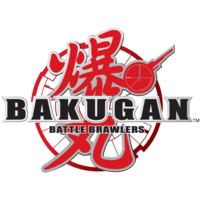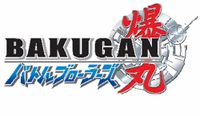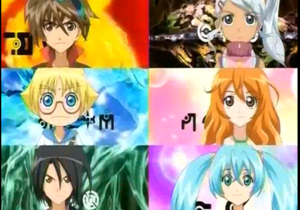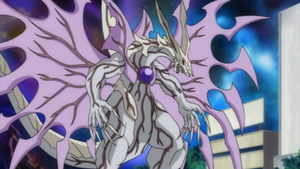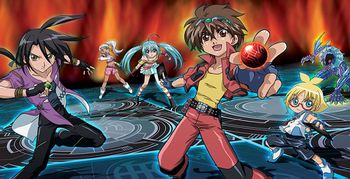Bakugan Battle Brawlers
| This article needs cleanup. Please help us by adding to or copyediting the article. |
| Bakugan Battle Brawlers | |
|---|---|
| Production | |
| Director | Mitsuo Hashimoto |
| Studio | TMS Entertainment Japan Vistec Nelvana |
| Network | TV Tokyo (JP) Teletoon (CA) Cartoon Network (US) |
| Episodes | 52 |
| Original run | April 5, 2007[1]-March 20, 2008 |
| Series Guide | |
| Followed by | Bakugan Battle Brawlers: New Vestroia |
Bakugan Battle Brawlers (爆丸バトルブローラーズ, Bakugan Batoru Burōrāzu?) is a Japanese-Canadian action-adventure anime television series produced by TMS Entertainment and Japan Vistec under the direction of Mitsuo Hashimoto. The story centers on the lives of creatures called Bakugan, and the Battle Brawlers who possess them. It is the first season of the Battle Brawlers series.
Though initially a failure in Japan, the series became popular in the Canada and the US, prompting the creation of three subsequent seasons, all of which aired in the west prior to its release in its home country.
Contents
Plot[edit]
Dan Kuso's life changed one day when random cards fell out of the sky. Children all around the world invented a game called Bakugan out of these cards and the strange toys that turned into creatures. Together with his friends Runo Misaki, Marucho Marukura, Julie Makimoto, Shun Kazami, and Alice Gehabich, they formed the Bakugan Battle Brawlers.
Unbeknownst to them, they would soon be dragged into a fight for the fate of Vestroia-the Bakugan's home dimension-against Naga, Masquerade, and the Doom Beings that seek to take over the world with the power of the Perfect Core.
List of Characters[edit]
Battle Brawlers[edit]
- Dan Kuso
 : The main protagonist of the series, Dan is a boy who loves playing Bakugan and gets frustrated easily. His greatest ambition is to be the number one battle brawler in the world.
: The main protagonist of the series, Dan is a boy who loves playing Bakugan and gets frustrated easily. His greatest ambition is to be the number one battle brawler in the world.
- Bakugan: Dragonoid (Drago) & Delta Dragonoid & Ultimate Dragonoid & Perfect Dragonoid
- Runo Misaki
 : Runo is a tomboy who loves playing Bakugan with people that have skills to show off. She also helps her parents run their family restaurant.
: Runo is a tomboy who loves playing Bakugan with people that have skills to show off. She also helps her parents run their family restaurant.
- Bakugan: Tigrerra → Blade Tigrerra
- Marucho Marukura
 : An extremely rich boy who is very generous and intelligent, a bit like a walking encyclopedia. He loves to play Bakugan and he also likes to work on strategies. He used to be very obedient to his parents just because he wanted to please them, but that changed when he met the Brawlers. He now has no regrets for the past, realizing that he only wanted to make his parents happy.
: An extremely rich boy who is very generous and intelligent, a bit like a walking encyclopedia. He loves to play Bakugan and he also likes to work on strategies. He used to be very obedient to his parents just because he wanted to please them, but that changed when he met the Brawlers. He now has no regrets for the past, realizing that he only wanted to make his parents happy.
- Julie Makimoto
 : Julie is a girl who tries to stay happy even when the worst has happened; her acting happy after something bad happened is generally just to hide up her true feelings. Julie forgets things easily, proving that she is a little scatterbrained at times.
: Julie is a girl who tries to stay happy even when the worst has happened; her acting happy after something bad happened is generally just to hide up her true feelings. Julie forgets things easily, proving that she is a little scatterbrained at times.
- Bakugan: Gorem → Hammer Gorem
- Shun Kazami
 : Shun is the former first-ranked Bakugan Brawler who later moves down to sixth position, and then up to third position. He is a master of Bakugan, and is also Dan's childhood friend. Shun is a loner, a boy of very few words, yet is willing to help his friends at every turn almost.
: Shun is the former first-ranked Bakugan Brawler who later moves down to sixth position, and then up to third position. He is a master of Bakugan, and is also Dan's childhood friend. Shun is a loner, a boy of very few words, yet is willing to help his friends at every turn almost.
- Bakugan: Skyress → Storm Skyress
- Alice Gehabich
 : A girl from Moscow who knows almost everything about Bakugan; usually, she just gives advice to the brawlers rather than brawl herself. She is also the granddaughter of Michael Gehabich.
: A girl from Moscow who knows almost everything about Bakugan; usually, she just gives advice to the brawlers rather than brawl herself. She is also the granddaughter of Michael Gehabich.
- Bakugan: Alpha Hydranoid
The Doom Beings[edit]
- Naga: The primary antagonist of the season. A rogue Bakugan who wants to control all power in Vestroia by stealing the completed Perfect Core.
- Hal-G
 : He assists Naga in his quest to get the Infinity Core from Wavern.
: He assists Naga in his quest to get the Infinity Core from Wavern. - Masquerade
 : The top-ranked Bakugan player whose goal is to send all Bakugan to the Doom Dimension with his Doom Card, so he can evolve his Hydranoid and have the ultimate Bakugan.
: The top-ranked Bakugan player whose goal is to send all Bakugan to the Doom Dimension with his Doom Card, so he can evolve his Hydranoid and have the ultimate Bakugan.
- Bakugan: Reaper, Hydranoid & Dual Hydranoid & Alpha Hydranoid
Media[edit]
Anime[edit]
- Main article: List of Bakugan Battle Brawlers Episodes
The fifty-two episode anime television series was produced by TMS Entertainment and Japan Vistec under the direction of Mitsuo Hashimoto in 2007. Bakugan Battle Brawlers made its debut in Japan on TV Tokyo on April 5, 2007[1], and was rebroadcast six days later on BS Japan. Nelvana Enterprises produced the English language version and premiered the series on the Canadian network Teletoon on July 2007 and then on Cartoon Network on February 24, 2008.
- Bakugan Battle Brawlers DVDs (Original Japanese)
Theme Songs[edit]
- Opening
- Number One Battle Brawlers (ナンバーワン・バトルブローラーズ, Nanbā Wan Batoru Burōrāzu?) by Psychic Lover (1–30)
- Bucchigiri Infinite Generation (ブッちぎり∞ジェネレーション, Bucchigiri Infinitto Jenerēshon?) by Psychic Lover (31–52)
- Ending
Books[edit]
Several Original English Language (OEL) books were published in collaboration with Scholastic Books and Del Rey. Most were simply adaptions based on the anime, though one OEL manga, Bakugan: The Evo Tournament, has an original plot set in the middle of the series.
- Activity Books: Bakugan: How to Draw, Collector's Sticker Book Volume One, Eye See It!
- Chapter Books: The Battle Brawlers, A Double Battle, Party Crashers, A Brand New Brawl
- Handbook: Bakugan Official Handbook
- OEL Manga: The Battle Begins!, The Masquerade Ball, A Feud Between Friends, Dan and Drago, Bakugan: The Evo Tournament
- Storybooks: Finding Drago, Masquerade Brawl
Video Games[edit]
Two video games were created based on the first season:
Trivia[edit]
- The title card, eye catch, and character introductions for this season and New Vestroia feature a stylized script that corresponds with the Japanese katakana and hiragana alphabets. The title card and eyecatch read "Acquire the Power of the Six Attributes" (むっつのしゅぞくなるものそれぞれにいまちからをあたえよう). The character introductions use the characters' Japanese names.
- This is the only season:
- Without alien brawlers, Bakugan Interspace, Aranaut, or Ren Krawler.
- Where no Brawlers were killed-only Bakugan, and the main villain (Naga) also does not explicitly die. (However, he also is never seen again, even in the final season when the Brawlers return to the Doom Dimension where he was supposedly banished to.)
- Where regular Bakugan battled without an enhancement like Bakugan Traps, Battle Gear, or BakuNano.
- With multiple core female Battle Brawlers-all the following seasons only have one female brawler in the main protagonist cast.
- Where Drago's final evolution isn't his first form in the next season.
- All the Japanese episode titles are named after well-known Japanese songs, mostly from the 1970s.
- In response to the 2011 Tōhoku earthquake and tsunami in March 2011, Bakugan Battle Brawlers was distributed for free online for a short time by TMS Entertainment, in order to help relieve the psychological stress of the disaster. [2]
Localization Changes[edit]
The following changes were made between the Japanese and English versions:
- Some names were changed to either better fit an English-speaking audience (such as changing Dan's full name from Danma to Daniel), or to obfuscate some more obvious references (such as Phoenix to Skyress).
- Replaced the original soundtrack (composed by Takayuki Negishi) with dub-made ones. The opening song was changed, and the ending theme was completely removed (as English broadcasts don't use ending themes).
- Some scenes were trimmed in order to meet the different broadcasting time limit. Some scenes may also have been deleted because they were deemed too violent for kids.
- References to death were removed.
- The BakuPod's digital voice was added into the dub.
- Aspect ratio was changed from 16:9 widescreen to 4:3 fullscreen, and thus some parts are cropped from the original Japanese version.
Other localization changes:
- The Arabic dub covered up the exposed skin from Julie, Runo, and Alice's outfits. Most of the names were also localized.
External links[edit]
- Bakugan Battle Brawlers on Wikipedia
- 爆丸バトルブローラーズ on Wikipedia (Japanese)
- TV Tokyo's Bakugan Battle Brawlers website
- TMS Entertainment's Bakugan Battle Brawlers website
Gallery[edit]
All the Battle Brawlers
At Runo's cafe, after the top Brawlers were defeated by Masquerade
References[edit]
| ||||||||||||||||||||||||||||
